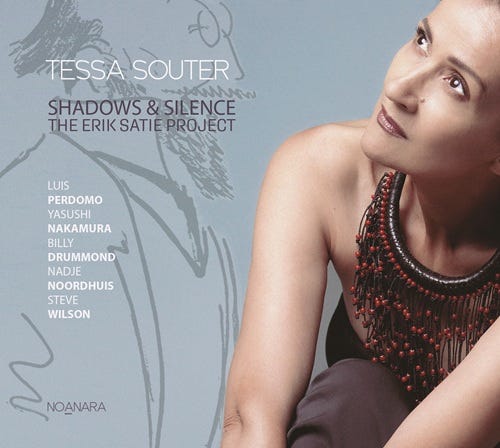Tessa Souter - Shadows & Silence: The Erik Satie Project
(Noanara Music, 2025)
In 1880, a 21-year-old Erik Satie left his parents’ house in the 9th arrondissement, moving to Montmartre, where he took up digs close to the famed Chat Noir nightclub, where he became a regular customer and then the house pianist and conductor. Satie live among the greatest communion of artists to concentrate in a specific place: Vincent van Gogh, Henri de Toulouse-Lautrec, Pierre-Auguste Renoir, and Edgar Degas, among many others. Writers, painters, sculptors, poets, they were thick in Montmartre in the late nineteenth century and it was from this environment that the Satie who composed the Gymnopédies emerged.
Now, in the present, we are seeing a spate of classical-jazz mashups: StarkLinnemann’s Transcending Beethoven (UCM Records, 2020, 2024) and Kurt Rosenwinkel and Jean-Paul Brodbeck’s The Brahms Project (Heartcore Records, 2025) appearing recently.
Enter vocalist/composer Tessa Souter. Tessa Souter's warm and intense contralto particularly stood out in commentary on her well-received previous recordings, Picture in Black and White (Noa, 2018) and Beyond the Blue (Motéma Music, 2012). Shadows & Silence: The Erik Satie Project, Souter takes a leap forward, composing lyrics for some of Erik Satie’s more jagged melodies, in the bargain producing a collection of interpretations that join the similarly inspired recordings, Karrin Allyson’s Ballads: Remembering John Coltrane (Concord Jazz, 2001) and Emilia Vancini’s If You Fall, You Fall (Espira, 2020) atop an impressive bundle of creativity.
If Erik Satie’s music was food, it would be dark chocolate: richly decadent and embarrassingly delightful. What Souter brings to this already intellectual and sensual music is her caramel colored voice: deeply hued with a sexy confidence and wicked sense of humor.
You came to me in camouflage of black and blue
I saw your face, but I did not see youThe gentle beauty of your sweet disguise
Belied the icy brink of your horizon
An inescapable abyss of lies
Of light-devouring dark sans rime ni raison“A Song For You (Gnossienne No. 1)”
Satie’s best known melody, Gnossienne No. 1, smells of champagne and Chanel, tinctured with absinthe. Souter adds a powerful hallucinogen inducing a fever dream at Absolute Zero. Her lyrics and voice capture 19th century Montmartre in blissful fog drifting above the twenty-first century vibe established by the solid rhythm section of pianist Luis Perdomo, bassist Yasushi Nakamura, and drummer (and husband) Billy Drummond. The cadence is dark and anxious, almost crepuscular.
“Mood” is a Ron Carter contribution to Miles Davis’ ESP (Columbia, 1965). The piece fits well here, deriving from Davis’ second great quintet and their journey into music less tethered to a harmonic paradigm and more modally motivated. Nadje Noordhuis’ muted trumpet furthers the spell and Steve Wilson’s serpentine soprano saxophone. Souter titled her treatment of Gnossienne No. 2, "Peace." It is an introspective voice-piano duet exploring the passage of time and the ultimate assimilation into the “whole:”
In the bright yellow glow of the crackling firelight
In the flickering fireflies dancing at twilight
There is peace
It is sleeping in the stars above us
Quiet canopy of oneness“Peace (Gnossienne No. 2)”
“D’Ou Venons-Nous (Gymnopedie No. 3)” is a lengthy rumination that owes as much to Morton Feldman’s minimalist inclinations as Satie’s sense of irony. Wilson punctuates the piece with his slippery soprano. When considering “Mood” for the project, Souter took a deep dive into ESP and discovered Cassandra Wilson’s mighty performance on her Miles Davis homage recording, Traveling Miles (Blue Note, 1999). Entitled “Never Broken” Souter opens the song up by using a simpler accompaniment that flattered her delivery.
Shadows & Silence: The Erik Satie Project is an inspired set that benefited from Souter’s keen ear and interest in taking jazz in directions other than the mainstream. This is a once in a decade recording whose charms are many.



This is a delightful review, I am ever so grateful you shared your excitement about Souter with us readers.
I cannot find the recording on my streaming platform Tidal. I wonder if the music publisher changed the title? Your review names it ‘Eternity and a Day: The Erik Satie Project’ however the image has words ‘Shadows & Silence: The Erik Satie Project’
Such an interesting album, thanks for the article !